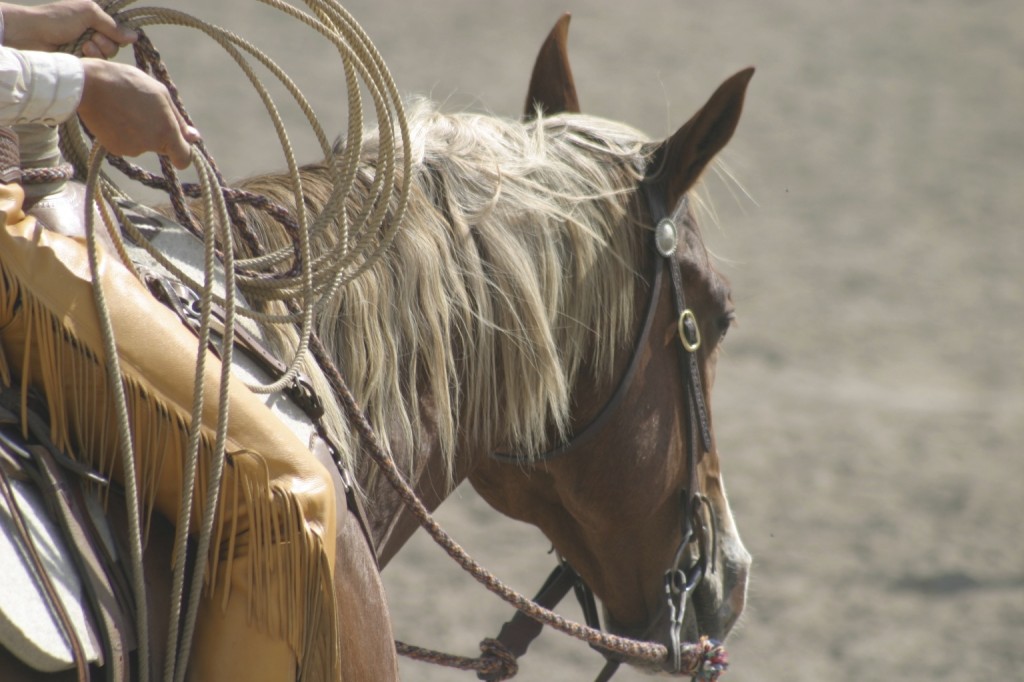Horsemanship in Action
Integrate your horsemanship clinic exercises into showday schooling
Written by Sylvana Smith
This article originally appeared in Eclectic Horseman Issue No.1
It was a Wednesday schooling show in January, halfway between Aberdeen and nowhere a perfect opportunity to field-test progress with a project horse who had a reputation for completely losing her cool at horse shows.
I expected that our good work at home and clinics would need refreshing in the show environment, scene of her past meltdowns, but I had picked the ideal, low-profile venue for our debut. Wrong. It hadn’t occurred to me that a midweek show in the Sandhills would draw all the illuminati of Southern Pines horse society.
True to reputation, my mount completely lost her cool in the warm-up area. Thank goodness for the skills we had brought home from Buck’s clinic two months earlier. One-rein stops, yin-and-yang circles, and deep bending lines were building safe harbor for the nervous Thoroughbred, and we would soon ease into the day.
Meanwhile, a friend overheard Eight-Time Olympian asking PanAm Games Silver Medalist if “the girl on the leaping horse” would be okay. PanAm Silver Medalist assured Eight-Time Olympian that I had matters in hand, or soon would. The “leaping horse” and I stayed together and put in some creditable jumper rounds, so I considered the showday a success.
Nonetheless, when Eight-Time Olympian published the next issue of his magazine, he featured a stern editorial about people “bringing unrideable horses to shows” and having to “wheel them around in circles.” Do you think he was talking about l’il ole me and my Leaping Mare and our one-rein stops? Ya wonder?
Eight-Time Olympian can question my strategies if he wishes, and question whether Leaping Mare should have been at that little schooling show in the first place. No one else at the show knew where we had been, what we had done, and what my untraditional strategies were achieving.
Surely no one even noticed that the mare was a perfect lady at her combined test two weeks later, or that she won so many events that year that she earned end-of-year tricolors in two jumper series, plus North Carolina Horse of the Year in the three-foot horse trials division. Ringside critics notwithstanding, this experience cemented my belief in the value of applying horsemanship clinic exercises to the show-ring warm-up.
If you’ve been to a few good horsemanship clinics, you’ve seen how simple, carefully designed exercises work magic to soften, supple, and relax horses; tune up their performance in every way. Why not integrate these proven maneuvers into your ride when you need them most right before being judged in a show or trial? Be forewarned that you’ll face two opposing forces: (A) the obvious value of the clinic exercises for getting the best performance from your horse, and (B) the ever-present possibility of having your methods misinterpreted.
Riding in a clinic of kindred spirits is quite different from riding at a showground of traditional hunter/jumper or dressage riders. If you want to use clinic exercises for maximum show-ring value without alienating your fellow competitors, some commonsense considerations apply.
Within the do’s and don’ts below if you have the experience to evaluate what your horse needs, the innovation to choreograph a truly unique and tailored warm-up ride, and most of all, the willingness to be different you can get great results by extending valued clinic exercises to your showday prep.
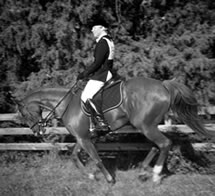
DO start your warm-up on the ground. You set the tone of the day with every interaction with your horse, starting with how you unload him from the trailer and lead him around to check out the sights. Good groundwork technique, faithfully followed at home, is easy to overlook in showday excitement. Yet this is a great opportunity for some unobtrusive halter-rope work. There’s no need to belabor it or draw attention to yourself. Just pay attention to small details and they’ll add up.
If my mount arrives at the showgrounds very excited and distracted, I break out my Virtual Round Pen. To the untrained eye, my Virtual Round Pen looks just like a cotton canvas longe line. But used creatively, it defines an invisible round pen in which we can get comfortable hooking on, changing eyes, and stepping the hindquarter around.
DO consider all the real estate options. If your horse gets fussy and tense in a crowded warm-up area, consider starting your warm-up in a quiet area on the edge of the parking field, or a warm-up area for another phase, then migrating to the busy warm-up area when you’re both ready. In the warm-up arena, resist the temptation to stick to the perimeter, as other competitors are likely to be doing. Think back to your last clinic, and how often you came off the rail in your work. Use all the real estate for maximum results.
DON’T drill on exercises that are going well. Under the stresses of riding in public, it’s tempting to stay within your comfort zone and repeat things your horse does well. That’s a fine way to avoid public mistakes, but an ineffective way to brush up all the skills you’ll be judged on in 10 minutes. If something is going well, move on to something else; not only a different exercise but a different type of exercise lateral to straight, slow work to faster gait, “bridled up” to loose rein, collected to stretched, precise to free-flowing.
DO be considerate of your fellow competitors. Dozens of riders can share a warm-up arena together because they all follow predictable patterns. Training and First-Level dressage riders, for example, will ride 20-meter circles, diagonals, the centerline, transitions up or down one gait, and not much else. Hunter/jumper riders will trot and canter the perimeter, pass down the jumping lane in one direction only, and call a heads-up if they’re going to do anything different. If you’re sharing the arena with a batch of dressage or hunter/jumper riders, you can fairly well predict where they will be and avoid collisions.
But your nontraditional movements; one-rein stops, wiggly lines, backing in circles, and such; completely break the pattern. Be considerate of fellow riders and don’t expect them to predict your unpredictable paths.
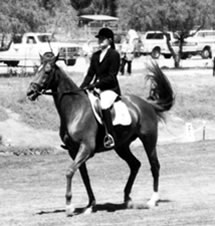
DO tailor your warm-up for the event. Each clinic exercise is designed to promote a different skill; and you won’t have time to do everything; so pick and choose from the repertoire to fine-tune the skills you’ll need most in your upcoming ride.
At a one-day horse trial, for instance, you’ll ride three completely different warmups for three distinctly different phases. The dressage phase demands steady rhythm, suppleness, relaxation, and balance. Your warm-up for dressage therefore will likely include one-rein stops, soft feel, deep bending lines, and frequent transitions. The cross-country phase, in contrast, demands speed, forwardness, and agility. You’ll probably drop the soft feel exercise and focus on upward transitions and transitions within a gait to balance for obstacles. The stadium-jumping phase demands precision response to aids at speed, so you’ll probably go back to the lateral exercises that were all but dropped from the cross-country warm-up.
DON’T wield the exercises like punishments. If you’re going to compete at Fort Bragg, be prepared for the wind to snap the flags in the middle of the warm-up, and cargo jets to roar overhead from the Air Force base next door. In this kind of environment, one-rein stops have created soothing time-outs for my sensitive Thoroughbred. The comforting benefits of this exercise would be lost if I snatched or grabbed the rein or kicked the hindquarter over in anxiety or frustration. It’s easy to get angry when our darlings embarrass us with public antics, but anger doesn’t work. The fast track to success is to offer safe zones, not more points of worry.
DO tailor your warm-up for your horse’s unique needs. In a perfect world, we’d have all the classic clinic exercises polished up all the time. Each exercise builds on some other foundation and serves as foundation for yet another exercise. Everything is interdependent. We know that. But on showday, you have to go with what you’ve got, and you’ve got limited time to warm up before each class. There’s no time to run through the full repertoire of 14-20 exercises from a typical clinic; even though you know they are all integral to your total training program.
With the constraints of reality and show schedules, the answer is to intelligently tailor your warm-up strategy; picking and choosing the most effective exercises to address your horse’s unique issues. Here’s a brief set of idea-starters for typical warm-up arena issues:

Above the bit. Start back at the trailer with the groundwork exercise to lower the horse’s head, working your hand back toward the withers so you can revisit this exercise under saddle later. Watch your bridling technique; the horse’s head should be waist-high or lower. In the warm-up area, start with loose-rein bending lines, lots of deep wavy figures, and ease into 5-meter circles with changes of bend through the center of the circle. If the horse is tense, use one-rein stops as soothing time-outs, and then modified one-rein stops where you release the rein when you get lateral softness, without necessarily coming to a full stop. When this is going well, ease into a few steps of soft feel, then holding the soft feel at one gait, then through transitions.
Behind the bit. The horse that travels “behind the bit” can be traveling freely forward without being truly “forward” in the dressage sense. For this kind of horse, I go easy on exercises that squelch forwardness, such as the soft feel exercise and one-rein stops. Instead, I focus on upward transitions with energy, perhaps going uphill, if the warm-up area is hilly. I’d also pay close attention to my hands to make sure I’m providing a reliable, soft connection for him to trust–not a waffling, flimsy contact that the horse can’t find.
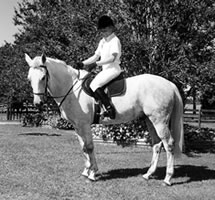
Fussy, fretful. This horse benefits from 10 minutes in the Virtual Round Pen before tacking up, then a gradual opportunity to migrate to the warm-up area from a quieter area of the showgrounds. I rely on one-rein stops and modified one-rein stops to create safe zones for a fretful mount. Careful though; it’s easy to overdo this exercise and end up badgering or overconfining the horse when he might just need to stride out on a loose rein for a while.
If the horse is fearful, I’ll offer lots of quiet stroking encouragement. Verbal encouragement “Eassssy, eassssy, easssy” –seems to have the opposite effect, so I just keep quiet, try to have a sense of humor about it, and ride as confidently as an electric horse will allow.
Stiff through the body. A few minutes of halter-rope work, breaking the hindquarter over in several different ways, sets the stage for success under saddle. You won’t see many straight lines in my warm-up with this horse. We’ll ride 10-foot-diameter circles on loose reins and change the bend through the center of the circle. We’ll ride deep wiggly lines on leg aids, looking for a clear lateral step of the hindquarters. We’ll do turns on the forehand with the reins dropped. We’ll back in circles.
For my event horse that travels slightly haunches-in along the rail during dressage tests, we’ll do circles haunches-out and sidepass in our warm-up to tune up response to the leg behind the girth, even though those skills aren’t required in any of his tests.
Stiff through jaw and neck. Even though the bulging jaw and stiff neck seem to be the problem, the real problem is that this horse’s feet aren’t free. This is a common problem we face when our horses are distracted by the excitement of the show scene. Jot down the full set of lateral/bending exercises from your last clinic. Write them on your arm if you have to, because these are going to save the dressage ride from being a string of 5s, or from having your hunter hack look more like a giraffe. Bringing the head around, one-rein stops, yin-and-yang circles, wiggly lines, serpentines, soft feel exercises all these things will massage the tension and brace from the jaw, poll, and neck while freeing up the feet.
Rushing, quick, tense. Look to exercises that build relaxation and quell forwardness, like one-rein stops, small circles, wavy lines, and backing in circles. If you have the space, slow the horse with circles rather than two reins.
Remember that your warm-up is yours by definition up until the moment you enter the arena; you can be different. My sister’s rushy Second Level dressage horse gets tense and pulls during the pre-ride laps around the arena, but he’s all business once he gets into the arena. So, whereas everybody else trots around the outside of the arena before their tests, my sister walks until well after the bell rings, and picks up a trot only as she enters the arena. She now consistently gets top scores.
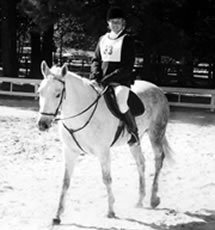
Bolting and bucking. Hooking on in the Virtual Round Pen can give the over-energetic horse a chance to blow off a little steam. If you have a Jekyll-n-Hyde character who stays quite calm until some surprise moment in a crowded warm-up, one-rein stops can defuse tension and keep you from interfering with other riders. Use your judgment though, knowing your horse. Sometimes riding through a little bolt and continuing on loose reins works better than overconfining.
Leaping Mare progressed to the point where Ms. Hyde didn’t appear in the warm-up until we got to cantering. Respecting the safety of other riders, at shows we usually didn’t canter in the group, and sometimes didn’t canter a single step before entering the dressage arena or heading out of the cross-country start box.
This offbeat strategy worked out just dandy, until we hit on a better strategy. Now, before going near the dressage warm-up, we don cross-country gear and have a breezy 20-minute gallop around an open field, if available. I’ve never done this with any other horse for any other dressage warm-up, but it’s magic for this high-energy princess, so I do what works. Be willing to be different, and to trust your own observations.
Dull to the leg. The leaping Thoroughbred princess has a placid, stoic brother whose steadiness has earned us nice dressage scores, but without the light response that makes a ride a joy. With him, now I’m more careful to notice every transition, even the first steps away from the trailer after mounting. I try to build in crispness with every step he takes on the ground or under saddle, not just when I’m officially “schooling.”
In the arena with this horse, I shun the exercises that squelch forwardness, such as one-rein stops and deep lateral work. Instead, I focus on bright upward transitions, looking for crisp response in every instance. Like my sister, I’ve been unconventional with the last step of my dressage test preparation. After the bell rings, Chance and I do a spirited hand-gallop around the perimeter, easing to a trot right before entering the arena. Dare to be different. Do what works
Dull to the rein. Does the horse plow right through your polite requests to slow? Jig through them? Then the exercises for the rushing horse or fretful horse might apply. Does the horse evade rein action by raising his head or bulging his jaw or simply pulling away to the side? Then the exercises for the above-the-bit horse or stiff-through-the-jaw horse might apply. Experiment and come up with a strategy that gets best results for you.
Aggressive or fearful to other horses. I’ve lumped aggressive and fearful together, because often the horse that pins his ears and makes faces seems to be saying, “I’m really worried about you, so get away from me.” I can distract him from his worries with a bit of shoulder fore, shoulder in, soft feel, driving him quickly forward, or circling away from the other horse– anything to defuse his anxiety while creating a safe zone. In this case, the clinic exercises provide the distraction, an indirect fix.
As you might have gathered, I don’t believe in coddling horses at home until everything is perfect and I can stamp them, “Made.” I take the greenies out in public early and often. The showday experience becomes an intrinsic part of their education, not something that happens someday after their educations are allegedly complete.
That’s why I’m such a big proponent of integrating the clinic exercises seamlessly into the showday experience. Skills that are solid at home can fall apart under the stresses and chaos of the showgrounds. What a great opportunity to field-test your homework and broaden the horse by the exposure.
The familiar clinic exercises help the horse find constancy in the unfamiliar environment while producing the same benefits that sold us on these methods in the first place.
This article originally appeared in Eclectic Horseman Issue No.1


